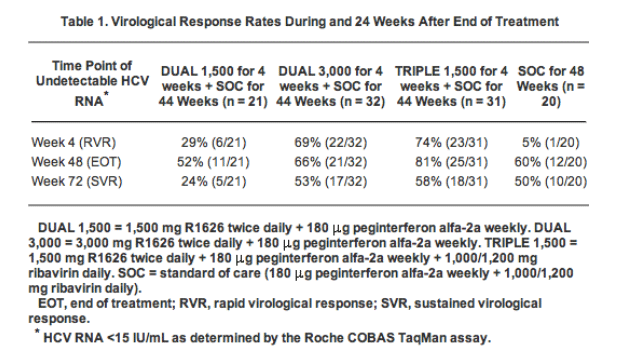| |
High relapse rate seen at week 72 for patients treated with R1626 combination therapy
|
| |
| |
Correspondence
Hepatology Oct 2008
Paul Pockros, M.D. 1, David Nelson, M.D. 2, Eliot Godofsky, M.D. 3, Maribel Rodriguez-Torres, M.D. 4, Gregory T. Everson, M.D., Ph.D. 5, Michael W. Fried, M.D. 6, Reem Ghalib, M.D. 7, Stephen Harrison, M.D. 8, Lisa Nyberg, M.D. 9, Mitchell L. Shiffman, M.D. 10, Anna Chan, Ph.D. 11, George Hill, M.D. 12
1Division of Gastroenterology and Hepatology, Scripps Clinic, La Jolla, CA
2Division of Gastroenterology, Hepatology, and Nutrition, University of Florida, Gainesville, FL
3University Hepatitis Center at Bach & Godofsky, Bradenton, FL
4Fundacion de Investigacion de Diego, San Juan, Puerto Rico
5Section of Hepatology, Division of Gastroenterology, University of Colorado Health Sciences Center, Denver, CO
6Department of Medicine, University of North Carolina at Chapel Hill, Chapel Hill, NC
7The Liver Institute at Dallas Methodist Hospital, Dallas, TX
8Brooke Army Medical Center, Fort Sam Houston, TX
9Kaiser Permanente, San Diego, CA
10Hepatology Section, Virginia Commonwealth University Medical Center, Richmond, VA
11Roche Pharmaceuticals LLC, Palo Alto, CA
12Hoffmann-La Roche Inc., Nutley, NJ
Letter
High Relapse Rate Seen at Week 72 for Patients Treated with R1626 Combination Therapy
To the Editor:
We recently reported the efficacy and safety of R1626, a prodrug of the hepatitis C virus (HCV) RNA polymerase nucleoside analog inhibitor R1479, when administered for 4 weeks in combination with peginterferon alfa-2a with or without ribavirin in HCV genotype 1-infected treatment-naive patients.[1] A synergistic effect was seen between the three drugs and, at week 4, the highest rate of virological response (74%) was observed in the combination arm of 1,500 mg R1626 twice daily, weekly peginterferon alfa-2a, and daily ribavirin (TRIPLE 1,500 arm) in contrast to 5% virological response in patients receiving peginterferon alfa-2a and ribavirin (standard of care) (Table 1). There was no evidence of development of viral resistance to R1626 during therapy. After week 4, all patients received peginterferon alfa-2a and ribavirin for a further 44 weeks to complete 48 weeks of treatment. We are now able to report the rates of virological response at end of treatment and the sustained virological response defined as undetectable HCV RNA (<15 IU/mL) at week 72, 24 weeks after the end of treatment (Table 1).

The highest rate of virological response (81%) at the end of the treatment period was observed in the TRIPLE arm, whereas end-of-treatment results for the other two experimental arms were similar (52%-66%) and comparable to standard of care. A relapse rate of 17% (2/12) was observed in the standard of care arm, in accordance with previous observations in treatment-naive HCV genotype 1-infected patients.[2] The highest rates of relapse were observed in the combination arm of 1,500 mg R1626 twice daily, weekly peginterferon alfa-2a (DUAL 1,500 arm; 55% 6/11) and in the TRIPLE 1,500 arm (28% 7/25). In 5 of the 7 patients in the TRIPLE 1,500 arm who experienced relapse, HCV RNA breakthrough was seen during the early stages of treatment. This coincided with stopping R1626 and/or temporarily discontinuing standard of care around study week 4 as a result of laboratory abnormalities - mainly, dose-dependent but reversible grade 4 neutropenia in the R1626-containing regimens. The relatively high incidence of grade 4 neutropenia in this study was considered a consequence of combining R1626 and peginterferon alfa-2a. These results further confirm the importance of achieving early and continued suppression of HCV RNA to undetectable levels to achieve sustained response.
On the basis of the observed synergy and encouraging efficacy results with the triple combination, further studies investigating longer durations of triple therapy, incorporating lower doses of R1626 and/or peginterferon alfa-2a, are underway to improve the efficacy/safety balance of this combination regimen. These studies have incorporated dose reductions of R1626 and of peginterferon alfa-2a at relatively higher neutrophil counts in an effort to avoid stopping the drugs for grade 4 neutropenia. The high relapse rates seen in our phase 2a study are disappointing but not surprising in light of the short period of R1626 dosing most patients received (2-4 weeks) and the interruptions of peginterferon therapy. One would not expect this degree of relapse with longer STAT-C therapy (at least 12 weeks) and without interruption of peginterferon; however, this point must be proven.
References
1 Pockros PJ, Nelson D, Godofsky E, Rodriguez-Torres M, Everson GT, Fried MW, et al. R1626 plus peginterferon Alfa-2a provides potent suppression of hepatitis C virus RNA and significant antiviral synergy in combination with ribavirin. HEPATOLOGY 2008; 48: 385-397. Links
2 Hadziyannis SJ, Sette H Jr, Morgan TR, Balan V, Diago M, Marcellin P, et al. Peginterferon-alpha2a and ribavirin combination therapy in chronic hepatitis C: a randomized study of treatment duration and ribavirin dose. Ann Intern Med 2004; 140: 346-355. Links
|
|
| |
| |
|
|
|